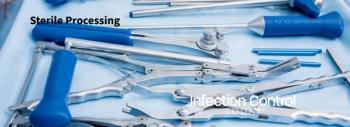
Monitoring and Maintaining HVAC Parameters Within the Sterile Processing Department
By Nancy Chobin, RN, AAS, ACSP, CSPM, CFER
Q: We have heard that we no longer have to worry about checking the temperature and humidity levels in the sterile processing department (SPD). Can you provide more information on this?
A: The Association for the Advancement of Medical Instrumentation’s Comprehensive Guide to Steam Sterilization and Sterility Assurance in Health Care ST-79 (2017) has revised the standards for temperature and humidity levels in the sterile processing areas.
Previously, AAMI had recommended the following temperature and humidity levels:
General work areas – 20-23 degrees C (68-73 degrees F)
Decontamination area – 16-18 degrees C. (60-65 degrees F)
Sterilizer access room – 24-29 degrees C. (75-85 degrees F) or as recommended by the equipment (sterilizer) manufacturer
Sterile storage and personnel support areas (e.g., toilets, showers, locker rooms) may be as high as 24 degrees C. (75 degrees F)
Due to the critical nature of the work performed in the sterile processing areas and the possible effects of temperature and humidity levels on packaging materials, biological and chemical indicators as well as sterile products, the temperature and humidity levels were to be monitored and documented daily. If the levels were out of range, the facility was required to document the action taken to resolve the issue.
The recommendation for the temperature range in the sterilizer access area was based on the efficiency of the equipment. Therefore, consulting with the sterilizer manufacturer regarding their recommended maximum temperature was recommended. If this area is not connected to a centralized recording system, the temperature should be manually documented daily.
During the updating of the 2010 version of ST-79 and its Amendments, numerous complaints were received from engineering and building personnel regarding the “unattainable” temperature and humidity levels as recommended by the document. The complaints included numerous citations from the Joint Commission when facilities failed to comply with the existing AAMI temperature and humidity levels. This led to the formation of an ad-hoc committee consisting of numerous interested parties including the ST-79 AAMI co-chairs, the Joint Commission, CMS, engineers, the American Society of Heating, Refrigerating and Air-Conditioning Engineers (ASHREA) and others to develop attainable environmental controls that promote personnel comfort and help make it clinically safe to process medical devices. The group understood that regulating environmental conditions is complex.
As a result of several meetings, the recommendations made included that users should work with their facility’s engineering department to establish policies and procedures for monitoring and maintaining the heating, ventilation and air conditioning (HVAC) system.
The environmental parameters (temperature and humidity levels) will be in a version of ASHREA 170, based on when the system was installed or upgraded (this is a document held by the Facilities Management department). Therefore, depending on which version of ASHREA 170 was in effect when the department was built or last renovated, those temperatures and humidity levels become the norm for your department. The existing temperature and humidity levels for the various areas of sterile processing no longer exist. Your facility should also establish and implement processes to monitor the HVAC performance parameters and have a mechanism to identify and resolve any variances within the areas/rooms throughout the sterile processing areas.
Your facility should designate who will be responsible to develop policies and procedures to monitor and maintain the required HVAC parameters within the sterile processing areas. AAMI recommends “maintaining records of monitoring results, that are retrievable, either from a central system or local log.” Some sterile processing departments wish to continue to monitor their own temperature and humidity levels however this is now optional as long as the records are retrievable from the central system.
As AAMI states, “The sterile processing area is considered a critical area; being outside the recommended environmental range by a small variance for a brief period of time may or may not have clinical significance; therefore, a multidisciplinary risk assessment should be performed to determine the correct response to any situation where environmental conditions fall outside the recommended range.”
Often personnel question how long their temperature and humidity levels can be out of range before they must take action? AAMI states that “the effects of the HVAC system falling out of range are variable. A small variance for a short amount of time might not be of clinical concern while longer periods of time could have clinical concern.” The bottom line is that AAMI cannot know the conditions in your department. For example, what packaging materials are used? Was it just the temperature that exceeded the level? The humidity only? Or did both the temperature and humidity exceed the levels? For what length of time? One-half hour or several hours?
To best determine your response, a risk analysis should be performed. Form an ad-hoc committee consisting of engineering, sterile processing management, perioperative services director, infection prevention and risk management. Determine the risks and develop a policy to address non-compliance with the facility’s temperature and humidity levels. When you assess a risk in advance, it avoids having to make decisions under stressful situations.
There are also some sterile processing personnel who are very concerned about the temperature and humidity levels in the decontamination area now that the previous AAMI recommended temperature and humidity levels are no longer in effect. It should be noted that the major reason why personnel in the Decontamination Area are complaining they are hot, is the personnel protective equipment being used. Impervious gowns, often made of plastic or heavy fluid resistant fabric, contain body heat because they do not allow body heat to escape. Therefore, personnel get uncomfortably warm or in some cases, hot, from the PPE, the physical nature of the work in the decontamination area, and the heat generated from the various types of mechanical cleaners (e.g., washers, cart washers). To help sterile processing departments with this issue, AAMI added a new Annex, Q4, “Alternative Cooling Methods for Personnel Working in the Decontamination Area/Room.” This Annex in ST-79 (2017) provides recommendations to deal with the heat in this area. Some of the recommendations include adjusting the amount of time spent in the decontamination area, use of cooling vests or collars, and keeping well hydrated.
In summary, the need for sterile processing personnel to remain current with all standards and practices is critical. The changes for HVAC needs in the sterile processing area need to be addressed by all facilities. Obtain a copy of the updated ST-79 and utilize its many resources to help comply with the new recommendations. Keeping current, especially in sterile processing is important for patient as well as employee safety.
Nancy Chobin, RN, AAS, ACSP, CSPM, CFER, is a sterile processing consultant and educator.
Reference: ANSI/AAMI: ST79:2017. “Comprehensive Guide to Steam Sterilization and Sterility Assurance in Healthcare Facilities.”
Newsletter
Stay prepared and protected with Infection Control Today's newsletter, delivering essential updates, best practices, and expert insights for infection preventionists.






